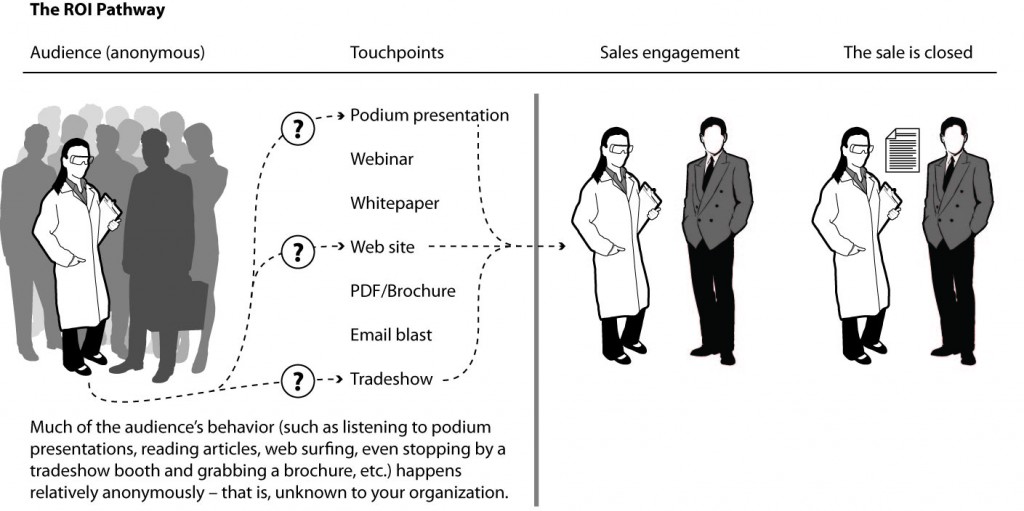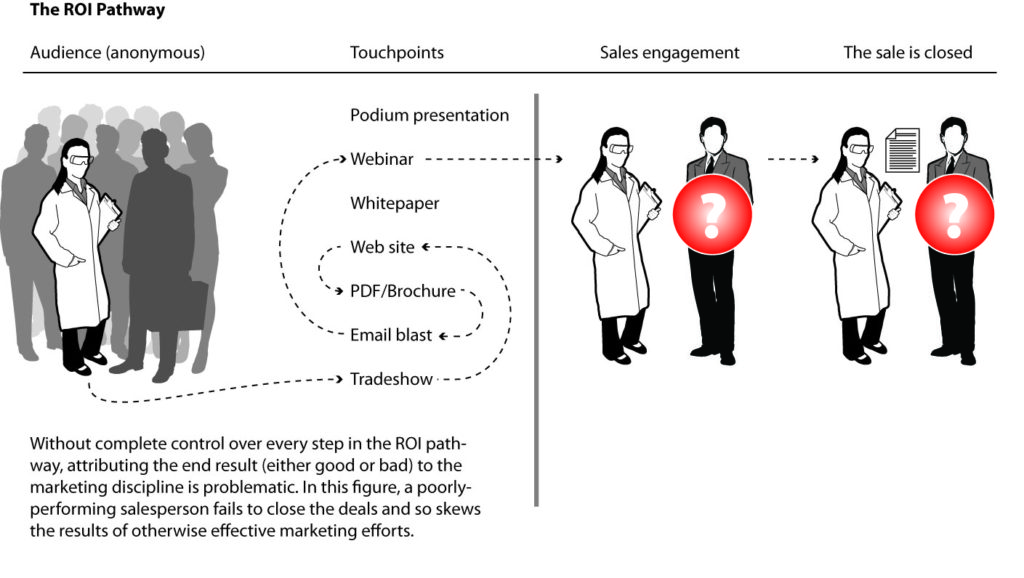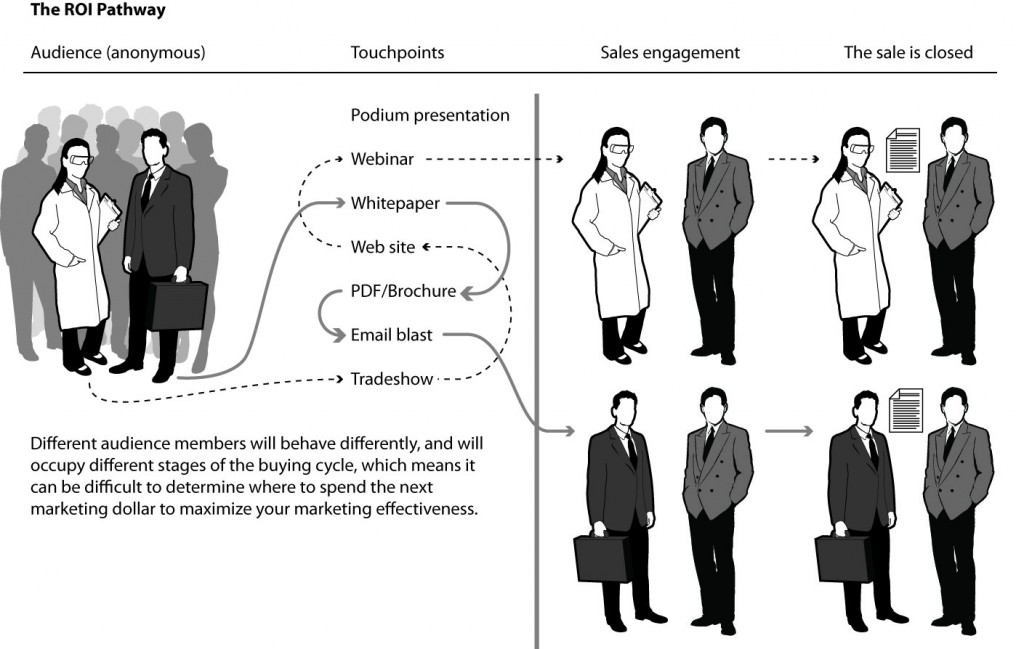Measuring Return on Investment (ROI) in Life Science Marketing (Part 2)
By David Chapin
SUMMARY
VOLUME 4
, NUMER 5
In this second of a series, we continue our look at return on investment (ROI) for marketing in the life sciences. We’ll outline the five systemic challenges to determining marketing ROI in the life sciences. In our next issue, we’ll outline the conditions and the steps required to determine marketing ROI.
The ROI pathway in marketing for the life sciences.
In our last issue we outlined the steps that a prospect (an audience member) follows as they step gradually (or even suddenly) closer to your life science organization. From the shadows of anonymity, they emerge into visibility. These steps are shown in a general way in Figure 1. At the far left of the diagram, the audience is completely anonymous. They might have heard of your organization, but your organization knows almost nothing about them.

Figure 1: The ROI pathway. There are many steps on the ROI pathway, from talking to the anonymous audience through your organization’s touchpoints, to sales engagement and ultimately to the close of a sale.
The first two systemic challenges to determining ROI for marketing efforts in the life sciences.
There are five systemic challenges to determining ROI for marketing efforts in the life sciences. We covered the first two of these in our last issue:
The visibility challenge: The primary target of life science marketing efforts should be to reach those prospects who are “anonymous” – still unknown to your organization. Because of their anonymity, exact measurements of their behavior are very difficult. This makes the determination of an exact ROI figure very difficult.
The third obstacle in determining ROI in marketing for life science companies: lack of influence – the control challenge.
The only way there can be any “return” on a marketing investment is if a prospect makes a purchase. But in the life sciences, there are many necessary factors before a purchase can occur. For example, large-ticket items typically have to be budgeted for. And once it is budgeted for, a salesperson has to close the sale.
Many of the factors in even this one simple example are out of the control of marketing. No amount of life science marketing can turn a bad salesperson into a good one, or turn a poorly managed client budget into a well-managed one, or turn a byzantine purchasing approval process into a streamlined one . The marketing function in most life science organizations just doesn’t have control over these factors. This is the control challenge in determining ROI.

Figure 2: The control challenge. Marketing does not have complete control over every aspect of the ROI chain. Shown in this figure is one example of this; marketing does not control the behavior or the effectiveness of the sales force.
In some sectors and for some products or services, the control challenge is much smaller; marketing does have significant control. One example would be ecommerce for disposable supplies and reagents: it is much easier to determine the total ROI when prospects are purchasing online without any interaction with a salesperson. But these types of transactions are not the focus of this article.
The fourth obstacle in determining ROI in marketing for life science companies: lack of consistency in your targets – the multiple buyer-types challenge.
All buyers are different. They have different needs for information. As we’ve seen in previous issues of this newsletter about the buying cycle in the life sciences, they can occupy different stages in the buying cycle. If buyers were cloned copies of each other, it would be easier to determine what marketing tactics work best, but they’re not, so a tactic that works well for one group of prospects might not work well for another. We’ll call this the multiple-buyer-types challenge.

Figure 3: The multiple buyer-types challenge. Just as all buyers do not follow the same path through the touchpoints, all buyers are not at the same point in the buying cycle – which means it can be difficult to determine where to spend the next marketing dollar.
Some buyers want to do all their research online, only approaching a salesperson when they have a clear understanding of all the issues and all the competitive offerings. Others want to visit multiple booths at a trade show, comparing offerings in a single day. Based on this very basic example, an upgraded web site would be a better investment for the first type of buyer, while an expanded trade show presence would be a better investment for the second type. Unfortunately, your population of prospects is composed of many types of buyers.
The fifth obstacle in determining ROI in marketing for life science companies: lack of meaningful measurement methodologies and data – the methodology challenge.
What role does your life science organization’s reputation play in influencing a purchase decision? Most people will agree that it will have an impact on purchase decisions. Many would also agree that reading an outstanding whitepaper or watching a compelling video would enhance your reputation. The key question in both cases is “how much impact will this have?” Due to the lack of meaningful measurement methodologies, the answers are difficult, if not impossible, to determine.
This is the “methodology challenge.” Getting meaningful data (by knowing what to measure and how to measure it) can be difficult, if indeed any measurements can be made at all. In some cases, conducting the research on a reasonably representative population with enough rigor to make the results meaningful would take a larger budget than the entire organization has to spend on marketing.
In sectors such as consumer packaged goods, the total sales volumes (and the resulting marketing budgets) are large enough to justify the significant research expenditures required to produce meaningful results. But most life science sectors aren’t blessed with budgets this large.
Life Science Marketing ROI – difficult to determine
Given these five challenges – visibility, attribution, lack of control, multiple buyer types, and methodology – it would seem that ROI is impossible to determine. Measuring the causes and effects of a complex, multi-step, mostly invisible process is difficult. Quite simply, in some areas of life science marketing, being able to determine an exact ROI is a false hope.
Brand equity is one such example. If the brand is improved by creating a new logo, then what is this worth, exactly? And what would you measure to determine the true ROI of creating a new identity and company image? You could begin by measuring awareness and perceived brand attributes before the new life science brand was introduced. You could later repeat the same measurements – after the new brand was introduced.
Having some metrics that describe awareness and brand attributes would be valuable, but this wouldn’t really enable you to determine ROI, unless you knew what a one-point increase in brand awareness was really worth. Again, the question isn’t simply, “What is our marketing ROI?” but rather “Now that I have the information, what should I do with it – in other words, where should I spend my next dollar?” If you knew the worth of a one-point increase in brand awareness as well as the worth of a different marketing expenditure, such as an increased trade show presence, you could compare the two to determine which investment would bring a higher return.
In the life sciences, determining what a one-point increase in brand awareness is really worth is very, very difficult. And the cost of doing so is frequently larger than the entire marketing budget.
Now, I am not arguing that you shouldn’t ever rebrand an organization. Or that you shouldn’t ever invest money in marketing. Even though ROI is difficult to determine in such cases, there can be significant value when rebranding is properly done. It is important not to confuse the ability to measure value precisely with the presence of value; don’t make the mistake of believing that since a measurement is difficult to make, the result must be zero.
Life Science Marketing ROI – difficult, but not impossible
Despite the arguments above against being able to measure ROI, there are some aspects of marketing where an attempt to determine ROI is not so fruitless. In some areas of marketing, some attribution can be made, some control is possible, multiple buyer types can be identified and tracked, some meaningful measurements can be made and it is possible to gain some visibility into the behavior of otherwise anonymous prospects. In other words, in some areas, significant and useful measurements can be made.
In cases where it is possible to make some measurements, how would you determine some sort of ROI ratio in the field of life science marketing? We’ll cover this fascinating subject in our next issue.
Summary
- There are five factors that impede the determination of ROI for marketing efforts in the life sciences.
- The visibility challenge: many of marketing’s effects “in the dark” – hidden from your organization.
- The attribution challenge: the path that prospects take from being unaware of your organization to engaging with a salesperson involves many steps, and it can be difficult to tease out which one had the most impact.
- The control challenge: there are many factors in the ROI pathway that the marketing function simply has no control over. Two classic examples are the budgets of your prospects, and the effectiveness of your sales staff.
- The multiple-buyer-types challenge: a tactic that works well for one group of prospects might not work well for another.
- The methodology challenge: getting meaningful data (by knowing what to measure and how to measure it) can be difficult and very expensive. In some cases the budgets required are simply too large to be practical.
- There are some areas where determining the ROI of marketing activities is an impossible dream. The value of re-branding an organization is one such example.
- There are other areas where making measurements and determining the ROI of marketing activities is not so hopeless. We’ll cover how to approach these in our next issue.
The Marketing of Science is published by Forma Life Science Marketing approximately ten times per year. To subscribe to this free publication, email us at info@formalifesciencemarketing.com.
David Chapin is author of the book “The Marketing of Science: Making the Complex Compelling,” available now from Rockbench Press and on Amazon. He was named Best Consultant in the inaugural 2013 BDO Triangle Life Science Awards. David serves on the board of NCBio.
David has a Bachelor’s degree in Physics from Swarthmore College and a Master’s degree in Design from NC State University. He is the named inventor on more than forty patents in the US and abroad. His work has been recognized by AIGA, and featured in publications such as the Harvard Business Review, ID magazine, Print magazine, Design News magazine and Medical Marketing and Media. David has authored articles published by Life Science Leader, Impact, and PharmaExec magazines and MedAd News. He has taught at the Kenan-Flagler Business School at UNC-Chapel Hill and at the College of Design at NC State University. He has lectured and presented to numerous groups about various topics in marketing.
Forma Life Science Marketing is a leading marketing firm for life science, companies. Forma works with life science organizations to increase marketing effectiveness and drive revenue, differentiate organizations, focus their messages and align their employee teams. Forma distills and communicates complex messages into compelling communications; we make the complex compelling.
© 2024 Forma Life Science Marketing, Inc. All rights reserved. No part of this document may be reproduced or transmitted without obtaining written permission from Forma Life Science Marketing.
